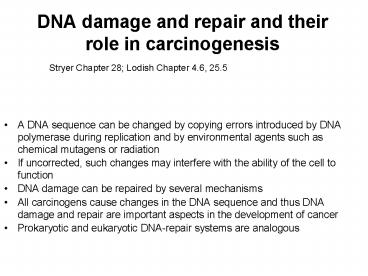DNA damage and repair and their role in carcinogenesis - PowerPoint PPT Presentation
1 / 24
Title:
DNA damage and repair and their role in carcinogenesis
Description:
helps to stabilize p53) Homologous repair of DSBs. via recombination. Non-homologous end joining ... Nucleotide excision repair (to remove thymine-dimers after UV) ... – PowerPoint PPT presentation
Number of Views:624
Avg rating:3.0/5.0
Title: DNA damage and repair and their role in carcinogenesis
1
DNA damage and repair and their role in
carcinogenesis
Stryer Chapter 28 Lodish Chapter 4.6, 25.5
- A DNA sequence can be changed by copying errors
introduced by DNA polymerase during replication
and by environmental agents such as chemical
mutagens or radiation - If uncorrected, such changes may interfere with
the ability of the cell to function - DNA damage can be repaired by several mechanisms
- All carcinogens cause changes in the DNA sequence
and thus DNA damage and repair are important
aspects in the development of cancer - Prokaryotic and eukaryotic DNA-repair systems are
analogous
2
General types of DNA damage and causes
3
Spontaneous C-A base pairing
4
Base deamination leads to the formation of a
spontaneous point mutation
5
Chemical carcinogens react with DNA and the
carcinogenic effect of a chemical correlates with
its mutagenicity
6
Aflatoxin can lead to a modification of guanosine
(in tobacco smoke)
7
Mutagens can be tested by their action on
bacteria
His- plates
mutagen
Salmonella test use his mutants deficient in
histidine synthesis (a). Mutagen induces
mutations that restore his (b).
8
(No Transcript)
9
U
Base excision repair pathway
U
AP
(apurinic/apyrimidinic recognizes missing base)
10
Mismatch repair
(likely coupled to replication)
11
Thymine-dimer formation
12
Thymine-dimers are removed by nucleotide
excision repair
XPXeroderma pigmentosum
13
(No Transcript)
14
(No Transcript)
15
(No Transcript)
16
Double-strand breaks occur after ?-irradiation or
replication fork collapse
17
Ataxia telangiectasia mutated
Mdm2-P (inactivates Mdm2, which helps to
stabilize p53)
AT patients develop lymphomas and leukemia and
are sensitive to ?-irradiation
18
Homologous repair of DSBs via recombination
19
(No Transcript)
20
(No Transcript)
21
(No Transcript)
22
(No Transcript)
23
Non-homologous end joining (can be error-prone!)
cs
DNA-PK
DNA end resection
24
What you need to know DNA damage can occur
spontaneously or through exogenous sources (UV
light, gamma-irradiation, chemotherapeutic
agents) I just want you to know that the
following pathways exist Base excision repair
(e.g., after spontaneous base deamination) Nucleot
ide excision repair (to remove thymine-dimers
after UV) Mismatch repair (defective in
hereditary colon cancer) Double strand break
repair -for homologous repair you need Rad51/52
(homology search and strand invasion) -for
non-homologous end joining you need DNA-PK
(DNA-dependent protein kinase, composed of
Ku86/Ku70 in humans plus the DNA-PK catalytic
subunit (Ku80/Ku70 complex shown in your
handout is yeast homolog). This process is the
preferred DSB repair pathway in humans and it is
often error-prone. ATM is key signaling protein,
senses double-stranded breaks and activates p53,
BUT is not involved in the repair process itself































